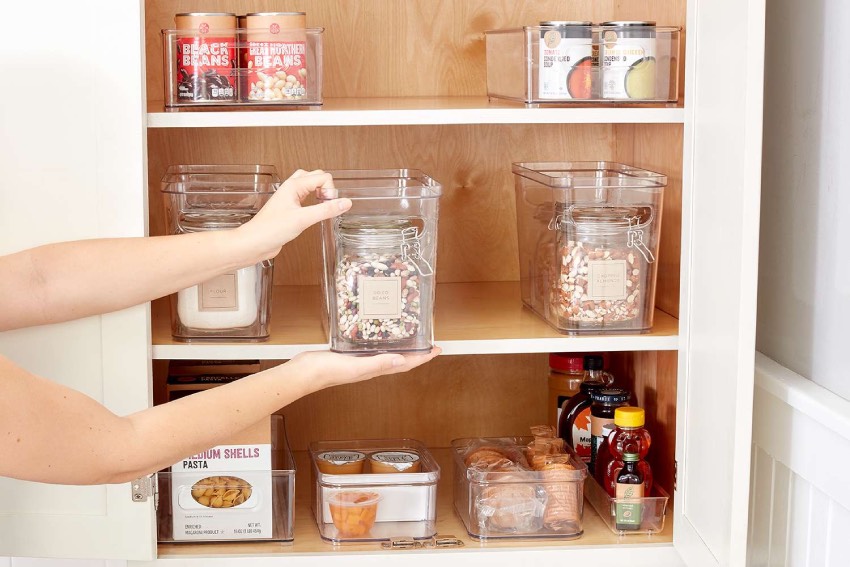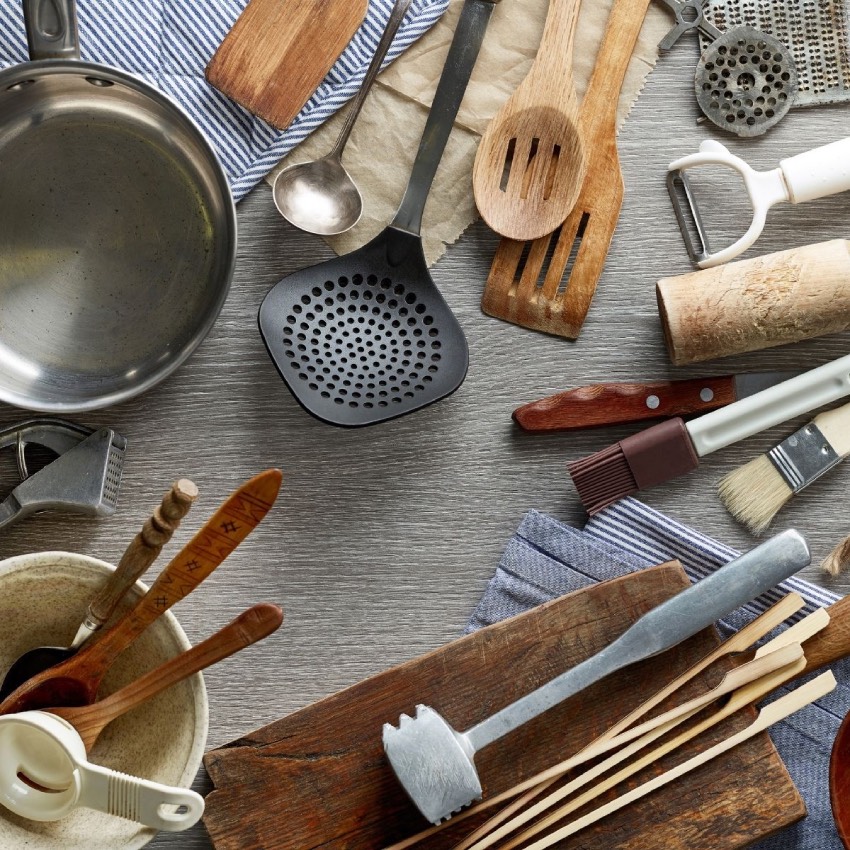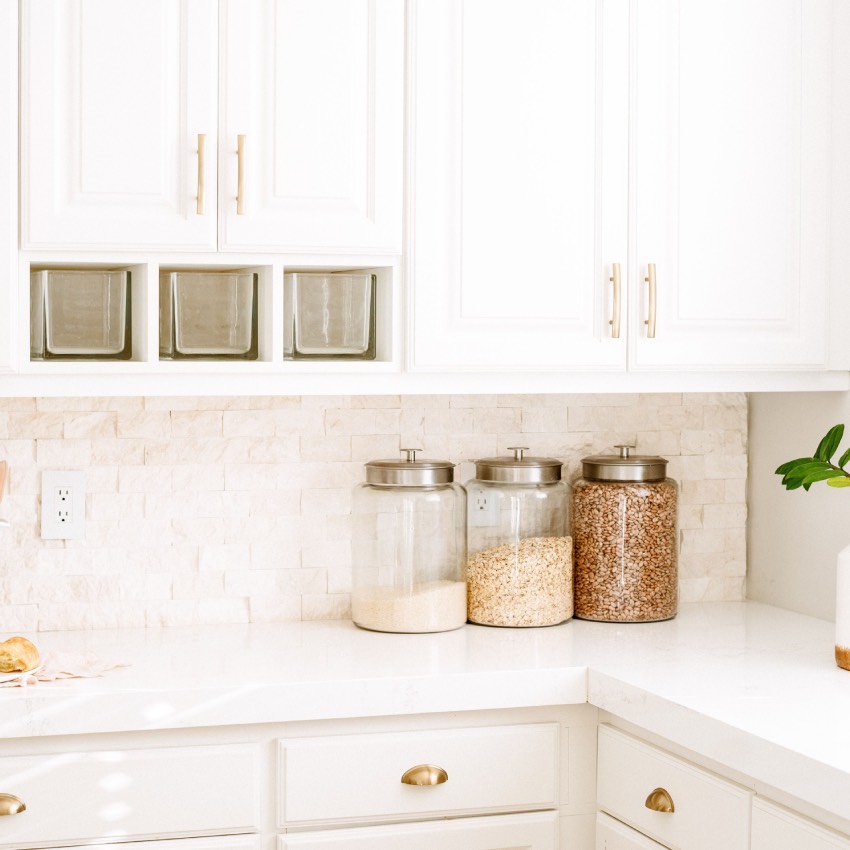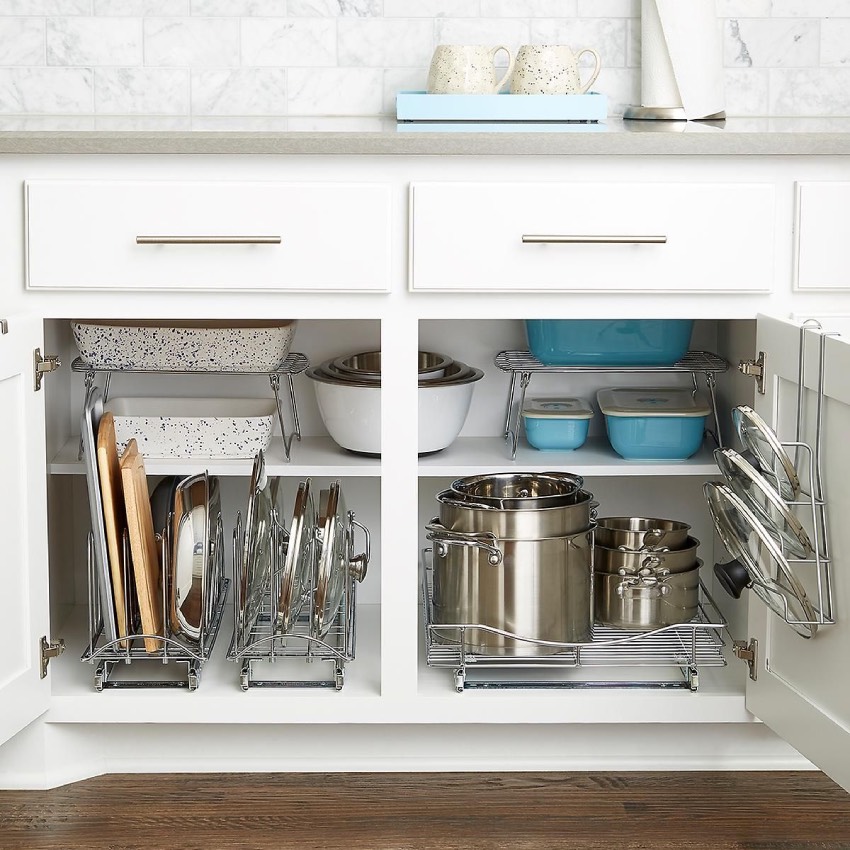There is no better feeling than having organized kitchen cabinets. Spending time disgruntled not being able to find the Thyme or other spices is a waste. It’s even more frustrating when you go down to the grocery store to buy it and then find out you had the spice all along. Organizing your kitchen cabinets is simple but not always the most straightforward thing to do.
You must first consider that everything needs to come out of your kitchen cabinets. Then we can talk about organizing the items into categories that make the most sense based on food groups. You’ll also want to consider how they fit and whether you need organization tools to use the space better.
Regardless of whether you want to know how to organize kitchen cabinets in a small or a large one. Here is the order you’ll want to focus on.
- Declutter and Clean
- Organize Into Groups
- Spaces that Work Best
Clear It All Out
The first step in getting your kitchen cabinets is taking everything out of your kitchen cabinets. This includes all your food, pots and pans, and miscellaneous items. During this process, you may find a plethora of items you never use that can be thrown out as well as items that can be problem solvers. Let’s talk about how to declutter the cabinets.
Everything Out and On Top the Floor
Most people are inclined to only take the things they need out of the kitchen cabinets. This doesn’t help because it doesn’t allow you to see the space available for your new groupings fully. It also won’t allow you to do a deep clean. Here is what you need to do when it comes to taking your items out.
- Everything needs to come out and be put on the floor. You can lay towels down on the kitchen floor so your pots and pans don’t get scratched.
- Do not place everything on the kitchen counters because it will clutter the space and will be too hard to see everything together.
- Take anything old in terms of food and throw it out into the trash bins. Expired foods should be thrown out.
- Pots and pans or any kitchen supplies that are broken and unable to be fixed also need to be thrown out.
The idea during this phase is to minimize the clutter but get rid of things you don’t need, don’t use, or are unusable anymore. You would be surprised to find out just how many stale snacks are hiding in the back of your kitchen cabinets.
Deep Clean
Next, when all the space has been freed up you need to do a deep clean. You don’t want to put things back in dirty spaces because it encourages a messy environment. So you will need to grab a few things to do a clean your kitchen cabinets.
What You Need:
Taking these materials, you want to remove any sticky residues and vacuum up any crumbs you may come across. While we will get into the planning of groupings, this is also an excellent time to start thinking about putting in any extra shelving if you need it or organizational products like spice racks.
Groupings That Work
Now that we have everything on the floor, we want to talk about the way we can group our products. First of all, we know that there are two large category groupings that we have to work with.
- Food Groups
- Material Groups
Our food groups and material groups are going to require different sections for organizational purposes. It doesn’t make a whole lot of sense to have our potato chips and peanut butter stashed behind the pots and pans. However, we can use rules that apply to both of them to make accessing our most used-items front and center.
In the next sections, these are just organizational tips that you can tweak and work with to find your perfect solution. When you are trying to figure out where to put things in kitchen cabinets and drawers, you have to remember your kitchen is unique in shape and size and so is what it will carry in terms of food and materials.
Food Groups
Food comes and goes in our kitchen cabinets, or at least it should do that! But we often find that we forget about our snacks. Again, throw away anything that’s past eating, and the rest we can manage. Certain groups are going to work well together in terms of space.
- Canned food can always be grouped. This also is your jellies, peanut butter, spreads, and more. These can be stackable and fit in unison with each other. Small items such as microwave popcorn and small boxes can fit great in this group.
- Big awkward bags and shapes that don’t fit in a circle or square can also be grouped together because you don’t want to put something uniform with something awkwardly shaped. This can disrupt the flow of multiple areas in a kitchen cabinet rather than containing it in one.
- Spices should all be put together and be used with a spice rack, so you don’t have to dig for them in the cabinets constantly. Rotating spice racks and ladder-level racks so you can see them all at once is great.
- Next, take the most commonly used foods and think about where it makes sense to put them in terms of accessibility. If you have peanut butter every day, ensure it’s in a reachable space. This is opposed to the popcorn packets you have once a week which can be nestled a bit further back.
This becomes particularly easier when you know how to organize kitchen cabinets as pantry space is available. This keeps food in a completely different section than your materials and cookware.
Materials and Cookware
Everything we have just done with your food now has to be done with your cookware and utensils. Everything needs to have a home. The easiest thing to do is to start with your silverware because there are typically a few draws that can be a true home for them.
Here are some things you can be to organize these types of utensils:
- Silverware holder and separator
- Vase or mason jars for bigger cooking utensils like spatulas
- Divider for a miscellaneous box dedicated to notes, pens, and paper.
These thinner and small draws are typically reserved for these types of tools because they don’t require much more than a foot in length of space. Putting them away first can be useful. Here is what typically can go into these drawers.
- Spatulas
- Can openers
- Scissors
- Cutlery
- Kitchen Knives
- Bottle Openers
Let’s look at the groupings of your cookware in general like this.
Small Items |
Large Items |
Misc. |
Cutlery |
Pots and Pans |
Sticky Notes |
Tools like lemon squeezers |
Knife Sets |
Calendars |
Bottle Openers |
Appliances |
Pens and Other Supplies |
Baking Tools (Spatulas) |
Bakeware |
|
Tupperware |
|
|
Consider whether this list of items can be stackable or not. Pans and pots can be stacked making them easier to put away. The same can be said for Tupperware. Miscellaneous often goes together because they don’t fit elsewhere. You need to take into account how to organize your kitchen cabinets diagram by drawing it out first if you can’t visualize it.
Spacing Options
Now that you have everything sorted into groups it’s time to find the right homes for everything. Granted not Everything always fits perfectly, and a member of one group may find themselves intruding on another’s space. Or sometimes we can find that two groupings were particularly well together so they share a home as well. Remembering how to organize kitchen cabinets without a pantry is slightly harder than with one.
Tips and Tricks to Remember:
- We’ve already dedicated the space to eliminating small drawer items with silverware and cutlery. Eliminating the things you already know makes it easy and less overwhelming to look at your groupings.
- Food is typically placed higher in cabinets while pots and pans are placed lower. The reason for thinking about food is that rodents have a harder time getting into the cabinets if the food is placed out of reach.
- Pots and pans are usually easily accessible but placed on the lower shelves since food is placed on the higher shelves. However, this does not apply to dishes and glassware. Reaching for dishes and glassware may be the most common thing. That’s why they are usually closest to eye level.
- Now keeping things out on the kitchen counter is a personal choice but a few things make more sense than others. Coffee makers, spice racks, daily used appliances, and spatulas are commonly seen. Picking and choosing what fits is important because too much can become cluttered.
Spacing Secrets
Having too much space can be difficult to organize, which is why you can use many tricks to get organized. We mentioned spice racks but there are a lot more things to consider. One of these things is slide-out drawers that can be installed so you don’t have to constantly knock over things to get to anything in the back.
Dish organizers are another great tool to place inside your cabinets to maximize space. They stand your dishes vertically instead of stacking them on top of each other. This allows you to use the space next to the item in the cabinet rather than waste the space above stacked dishes.
To find any of these organizers you can head to a store like The Container Store or Bed Bath and Beyond to find all sorts of organizing tool kits to fit different needs.
Step By Step
The important thing to remember when you are trying to recognize your kitchen pantry or kitchen cabinets is to take it step by step. If you try to skip over something, you may find yourself doing the same thing very soon. If you go through all the proper steps you may have a system in place that doesn’t need to be re-upped every few months.
By dedicating specific space to specific groupings you can find things without having to trample over other food groups. And as we go through this process we may realize we need a lot less than we think. This is the beauty of organizing. Less waste starts to become natural.



